Actility forms roaming partnership with Helium
- October 20, 2021
- Steve Rogerson

French IoT connectivity firm Actility has formed a roaming integration partnership with Helium to unlock affordable and ubiquitous coverage for millions of IoT devices.
This roaming integration is made possible by the Helium blockchain, which allows LoRaWan compatible devices already supported by Actility to use coverage provided by the Helium network and pay a fraction of the cost for data transfer. The interoperability is done through Actility’s ThingPark Exchange LoRaWan IoT peering hub.
The Helium network decentralises connectivity and expands access to the internet worldwide. In the two years since the network’s launch, it has achieved global adoption with more than 215,000 hotspots deployed in over 19,000 cities. Through this integration with ThingPark Exchange, Actility will be able to bring the Helium network coverage immediately to 25 already connected networks worldwide, spanning large nationwide public LoRaWans, multinational corporate private networks, and a set of satellite networks, giving them access to scalable, secure and manageable peering.
As a result of this partnership, all IoT devices served by the networks that are connected to ThingPark Exchange can now roam between Helium-compatible hotspots and the networks from all the other providers joining the peering platform, such as Actility-powered public LoRaWans managed by Orange in France, KPN in the Netherlands, Proximus in Belgium and Swisscom in Switzerland.
The number of roaming networks is increasing as networks join both from more than 50 large-scale users of Actility’s ThingPark Wireless IoT platform and others using standards-compliant third-party network servers.
Actility says this integration signals its commitment to expand the LPWAN integration to all types of LoRaWans, and to advance the Helium network ecosystem by offering roaming to public and private LoRaWans that support large-scale enterprises worldwide.
“The growth of the Helium network has been explosive,” said Actility vice president Alper Yegin. “By creating a roaming integration with the Helium network, we are now able to offer any LoRaWan, public or private, access to this coverage, enabling them to deploy applications in more markets faster with low cost and less hassle, while also bringing more users to hotspot owners to maximise their rewards.”
Actility supports various use cases, including IoT applications for smart industries and cities, energy and utilities, logistics and supply chain, facility management, precision agriculture and proximity detection and contact tracing for Covid-19, by various partners including Cisco, Volvo, Veolia, Schneider Electric, Accenture, Quuppa, Olympus and now Helium.
Notably, Bouygues Construction Group tracks more than 20,000 pieces of equipment in real time using Helium-compatible Abeeway sensors from Actility, which Volvo also uses to optimise its yard management in its France and USA truck plants. In Saudi Arabia, Red Sea Development is deploying over 39,000 Helium-compatible LoRaWan trackers for construction workers and vehicles to ensure employee safety using location-based insights. Even consumers can benefit from roaming when tracking their goods and pets.
“The Helium network’s mission and the driving force behind our decision to partner with Actility is to democratise the internet through ubiquitous connectivity,” said Helium CEO Amir Haleem. “We’re proud to team up with Actility and expand connectivity to millions of IoT devices that can now roam on the largest and fastest-growing LoRaWan in the world.”
Co-founded by Haleem and Shawn Fanning in 2013, California-based Helium is building a peer-to-peer wireless network to simplify connecting devices to the internet by letting anyone become a network operator. CEO Haleem comes from a background in triple-A video games. Helium is backed by Google Ventures, Khosla Ventures, Union Square Ventures, Multicoin Capital, FirstMark, Marc Benioff, Shawn Fanning and other VCs. The network is live in more than 19,000 cities globally.





